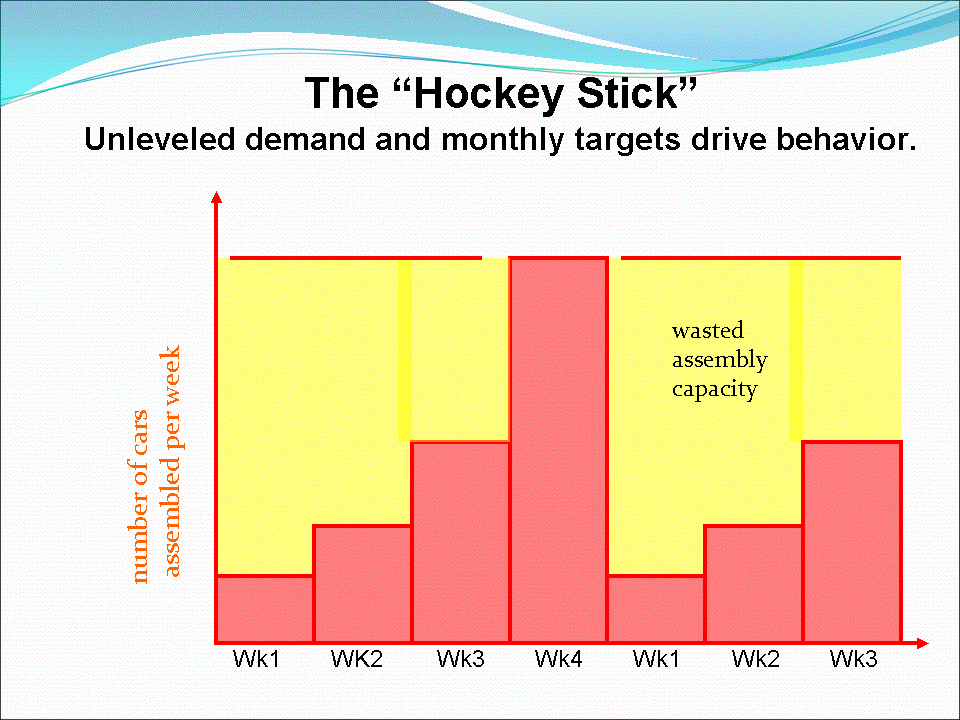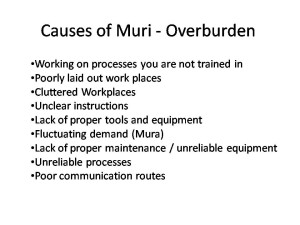Lean Manufacturing Wastes
Just what are Muda, Mura and Muri? The 3Ms of waste in Lean Manufacturing.
When people think of waste in manufacturing they usually only think about all of the scrap material that gets thrown away or if your lucky recycled, they often forget about all of the other actions that waste our time, our resources and our MONEY..
When someone who has had some contact with Lean Manufacturing talks about waste they are often talking about Muda, or the seven wastes (or 8+ wastes depending on your definitions), but they often forget the other wastes defined within the Toyota Production System; Mura and Muri.
 The 3 Ms of Lean
The 3 Ms of Lean
When Japanese companies talk about waste they usually talk about the three Ms; Mura, Muri and Muda. While most people who have had contact with lean manufacturing will have been made aware of the 7 wastes and Muda they often have not been introduced to Muri and Mura at all. Yet these wastes are often far more important to tackle than Muda and often are the underlying causes of the Muda that you observe within your processes.
While Muda is the non-value adding actions within your processes; Muri is to overburden or be unreasonable while Mura is unevenness. I will discuss these terms below.
Muda, The Seven Wastes
Muda is any activity or process that does not add value; a physical waste of your time, resources and ultimately your money. These wastes were categorized by Taiichi Ohno within the Toyota production system, they are;
- Transport; the movement of product between operations, and locations.
- Inventory; the work in progress (WIP) and stocks of finished goods and raw materials that a company holds.
- Motion; the physical movement of a person or machine whilst conducting an operation.
- Waiting; the act of waiting for a machine to finish, for product to arrive, or any other cause.
- Overproduction; Over producing product beyond what the customer has ordered.
- Over-processing; conducting operations beyond those that customer requires.
- Defects; product rejects and rework within your processes.
To this list of the original seven wastes most people also add the following;
- Talent; failing to utilize the skills and knowledge of all of your employees
- Resources; failing to turn off lights and unused machines
- By-Products; not making use of by-products of your process
Many “lean” initiatives fail to see past the elimination of Muda and believe that the point of Lean is to just eliminate waste. This leads to implementations that initially appear to save money but quickly fall apart and revert as problems such as customer demand fluctuations and supplier problems occur. They have failed to tackle the other forms of waste identified by Toyota;
Mura the Waste of Unevenness
Mura is the waste of unevenness or inconsistency, but what does this mean and how does it affect us?
Mura creates many of the seven wastes that we observe, Mura drives Muda! By failing to smooth our demand we put unfair demands on our processes and people and cause the creation of inventory and other wastes.
One obvious example is production processes where the manager is measured on monthly output, the department rushes like mad in the final week of the month to meet targets, using up components and producing parts not actually required. The first week of the month is then slow due to component shortages and no focus on meeting targets. This gives us the hockey stick graph of production as we see here on the right, far better to smooth out production and work at the demand of the customer.
Muri the waste of Overburden
Muri is to cause overburden, by this we mean to give unnecessary stress to our employees and our processes. This is caused by Mura and a host of other failures in our system such as lack of training, unclear or no defined ways of working, the wrong tools, and ill thought out measures of performance.
Again Mura causes Muda, the seven wastes are symptoms of our failure to tackle Mura and Muri within our processes not the root cause!
`
Muda, Mura, Muri Video
Remove Muda, Mura and Muri
Lean Manufacturing is about the removal of waste; but not just Muda (non-value adding steps), it is about removing Mura and Muri too. In fact by concentrating on solving Mura and Muri you prevent the creation of Muda.
By working on Just in Time (JIT) principles with Heijunka, Kanban and other techniques you enable production smoothing and flow; removing the causes of Mura, unevenness. The other lean tools such as 5S and TPM help you to remove other causes of overburden removing Muri, overburden.
You should first concentrate on ensuring that your Mura is removed and creating a level predictable flow; this in turn highlights the Muri (unreasonableness) within your system which can then be eliminated. By following this route you will often eliminate the vast majority of Muda that is present within your system.
Muda, Mura and Muri can be eliminated or signifcantly reduced if you implement the various lean tools and principles. But don’t just rush in to try and highlight and remove the muda in the hope of making a quick impression on your boss; it will be a short lived success as without tackling the other Ms Mura and Muri you will find the other wastes of Muda returning to haunt you.



Wonderful Post! According to me, In tough economic times like these we need to look at every area we can save money. Since time is money, wasted time is wasted money. By eliminating muda from the workplace we can save money and become more productive.
hi
can you help me a 5s sen data to me
tks
Yes, muda is a very good concept even in our personal lives. In fact, we sometimes unconsciously inflict this waste on ourselves and our business because we are ignorant. What about muri (overburden waste)? This is exactly what everybody does… failing to level our activities… trying to catch up at the last moment…Thanks so much that I have learned these.
MURA & MURI are very good concepts in every industry with MUDA. To eliminate all wastes we must work on MURA & MURI other wise MUDA starts. generally in every industry not follwoing MURA. it’s required to reduce unevenness production flow. these 3M s are having key role while implementing lean manufacturing.
thanks for giving such a good information
So, I’m looking at our order processing and looking at how the order is taken over the phone and mapping out the process till the point of goods going out of the door. We have identified a lot of waste where salespersons are writing down orders which is then passed to other colleagues etc. Is the method of Muda or Muri applicable here??